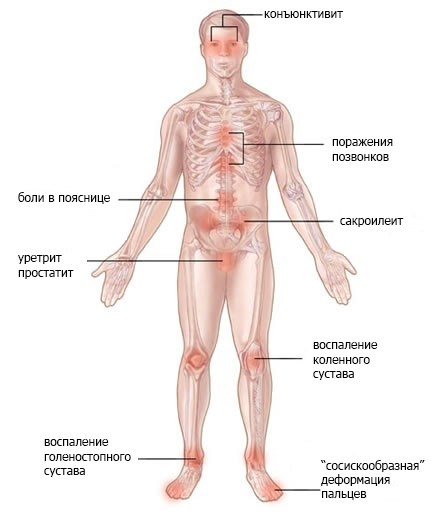Among sexually transmitted diseases, chlamydia – one of the most common today.
The slow development of symptoms of the disease or their complete absence leads to late treatment of patients for specialized medical care.
Complications such as urethritis, prostatitis, vesiculitis in men, as well as endometritis, salpingitis, adnexitis and infertility in women often occur.
One of the most serious complications is Reiter's disease or urethrooculosynovial syndrome. On estet-portal.com, read about the clinical picture of such complications of chlamydia as Reiter's syndrome, as well as methods for diagnosing and preventing this disease.
Causes of complications: genetic and infectious
Reiter's syndrome (Reiter's disease) – sympathocomplex that occurs after infectious diseases in persons with a genetic predisposition (carriers of the HLA-B27 antigen).
Reiter's syndrome includes damage to the urinary organs, joints, conjunctiva of the eyes, skin and mucous membranes.
Most often, a complication occurs in the presence of chlamydial infection – sporadic form of the disease. Also, Reiter's disease can occur after suffering enterocolitis caused by salmonella, shigella or yersinia – epidemic form.
It is assumed that infectious agents have certain antigenic structures that cause an immune response of the body in the form of urethro-oculosynovial syndrome in people with a genetic predisposition.
Follow us on Instagram
Specific clinical picture of the complication: Reiter's tetrad
The first manifestation of Reiter's disease is urethritis with mucopurulent discharge from the urethra.
Prostatitis, sclerotic balanitis may also develop.
Second manifestation – bilateral conjunctivitis or uveitis.
Rarely, optic neuritis may occur.
The third specific manifestation of the complication– arthritis.
Reiter's syndrome is characterized by symmetrical arthritis that affects the small joints of the foot, ankle and knee joints, and the spine.
The last manifestations of complications are skin and mucous lesions in the form of psoriasiform rash, keratoderma of the palms and feet.
 In addition to the history and the characteristic clinical picture, it is necessary to conduct mandatory studies to diagnose Reiter's disease.
In addition to the history and the characteristic clinical picture, it is necessary to conduct mandatory studies to diagnose Reiter's disease.
• in the general blood test: slight hypochromic anemia, elevated ESR;
• urinalysis: leukocyturia; • biochemical blood test: increase in alpha2- and beta-globulins, sialic acids, CRP;
• cytological examination: detection of chlamydial infection;
• PCR: detection of pathogen DNA (Chlamydia trachomatis);
• examination of synovial fluid: neutrophilia, leukocytosis, the presence of chlamydial antigens, rheumatoid factor is not determined.
Instrumental methods include X-ray examination of the joints: it is possible to visualize asymmetric periarticular osteoporosis, narrowing of the joint space, erosive-destructive phenomena, signs of sacroiliitis.
Chlamydia diagnostic methods: advantages and disadvantages
 Since Reiter's syndrome most commonly occurs in patients with a history of chlamydial infection, several guidelines should be followed.
Since Reiter's syndrome most commonly occurs in patients with a history of chlamydial infection, several guidelines should be followed.
The patient needs to be told about the possible complication of the disease – Reiter's syndrome. If you experience any symptoms from Reiter's tetrad.
Chlamydia prevention also includes sanitation and timely treatment of chronic foci of infection, especially of the genitourinary system.
Thank you for staying with estet-portal.com. Read other interesting articles in the "Dermatology" section. You may also be interested in:
Female condoms, diaphragms and other methods of contraception









Add a comment